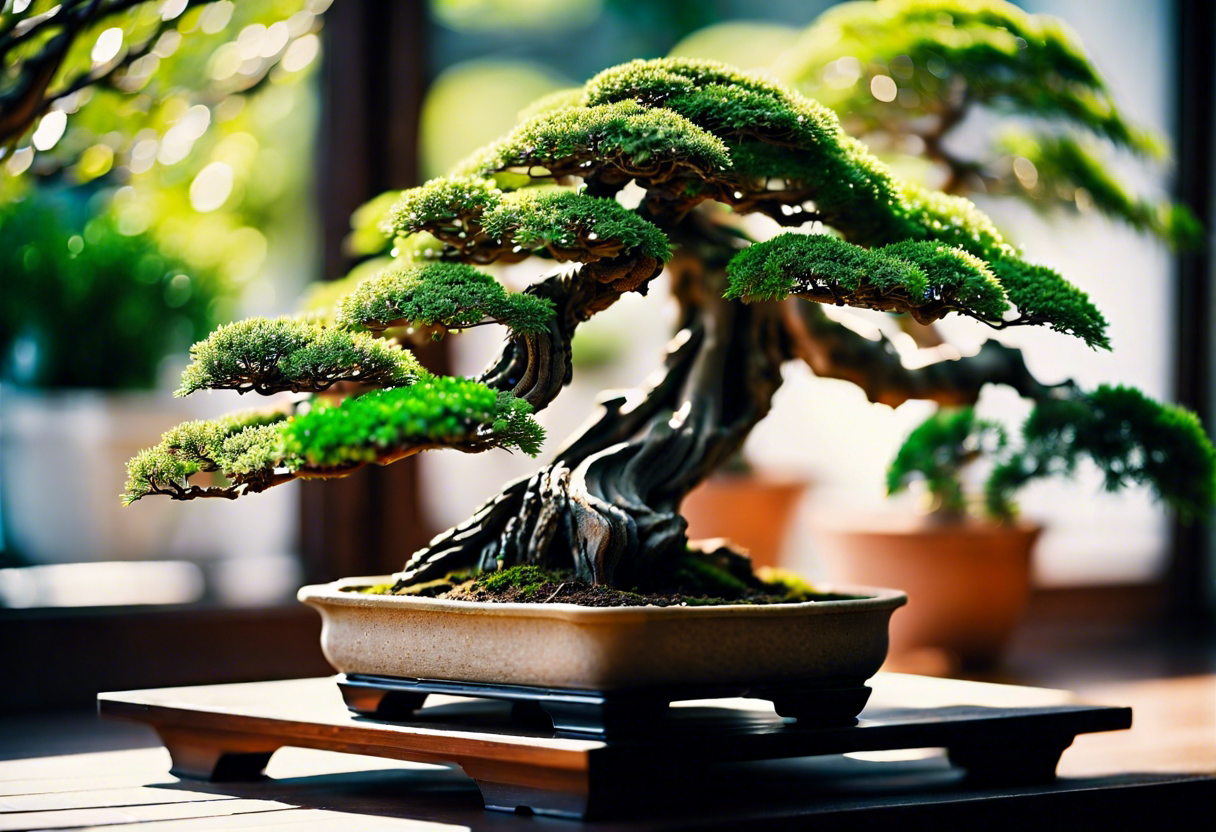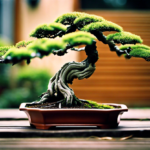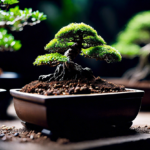Top 10 Best Bonsai Trees for Small Spaces
When it comes to adding a touch of nature to small living areas, bonsai trees are the perfect choice. These miniature trees not only bring a sense of tranquility and beauty but also thrive well in limited spaces. If you’re looking to enhance your small space with bonsai trees, here are the top 10 best varieties to consider:
-
Chinese Elm (Ulmus parvifolia): Known for its graceful, arching branches and small leaves, the Chinese Elm is one of the most popular bonsai trees for beginners. It adapts well to different light conditions, making it ideal for indoor spaces.
-
Ficus Bonsai (Ficus benjamina): With its glossy leaves and impressive aerial roots, the Ficus Bonsai is a stunning choice for small spaces. It is relatively easy to care for and can thrive in both bright and low light environments.
-
Jade Bonsai (Crassula ovata): The Jade Bonsai is a symbol of good luck and prosperity. Its fleshy leaves and thick trunk make it a visually appealing addition to any small space. This tree requires minimal watering and maintenance.
-
Dwarf Pomegranate (Punica granatum): For a pop of color in your small space, consider the Dwarf Pomegranate bonsai. With bright orange-red flowers and miniature fruit, this tree adds vibrancy to any setting.
-
Japanese Maple (Acer palmatum): Renowned for its stunning foliage that changes color with the seasons, the Japanese Maple bonsai is a favorite among enthusiasts. It thrives in both indoor and outdoor environments.
-
Juniper Bonsai (Juniperus): Juniper bonsai trees are known for their rugged appearance and resilience. These trees prefer ample sunlight and well-drained soil, making them ideal for small outdoor spaces.
-
Trident Maple (Acer buergerianum): The Trident Maple bonsai features three-lobed leaves and intricate branch structure, adding a sense of elegance to compact spaces. It fares well in full sun to partial shade conditions.
-
Crassula Bonsai (Crassula ovata): Also known as the Money Tree, the Crassula bonsai is a symbol of prosperity and wealth. Its fleshy, oval-shaped leaves and thick trunk make it a visually striking choice for small spaces.
-
Boxwood (Buxus sempervirens): Boxwood bonsai trees are prized for their evergreen foliage and ability to withstand frequent pruning. Perfect for shaping into intricate designs, these trees are a great addition to small indoor settings.
-
Azalea Bonsai (Rhododendron simsii): With its vibrant, funnel-shaped flowers, the Azalea bonsai adds a burst of color to small spaces. It requires consistent watering and partial shade to thrive indoors.
Incorporating bonsai trees into small living areas can bring a sense of serenity and natural beauty. By choosing the right bonsai tree species that suit your space and lifestyle, you can create a mini oasis that enhances your overall well-being.
For more information on bonsai tree care and maintenance, you can visit Bonsai Empire.
Top Tips for Caring for Bonsai Trees in Limited Spaces
When it comes to cultivating bonsai trees in small spaces, proper care is essential for their health and longevity. Here are some top tips to ensure your bonsai thrives in a limited space environment:
1. Choose the Right Bonsai Species: Selecting the best bonsai tree for small spaces is crucial. Opt for compact varieties like the Ficus Retusa, Chinese Elm, or Fukien Tea, which are better suited for confined areas due to their small size and adaptability.
2. Light and Temperature: Proper lighting is vital for bonsai trees. Ensure your tree receives adequate sunlight, preferably by placing it near a window where it can get indirect sunlight. Additionally, maintain a consistent temperature around your bonsai to promote healthy growth.
3. Watering: Overwatering is a common mistake in bonsai care. Check the moisture levels of the soil regularly and water only when the topsoil feels dry to the touch. Adjust your watering schedule based on the specific needs of your bonsai tree species.
4. Pruning and Trimming: Regular pruning and trimming are essential to maintain the shape and size of your bonsai tree. Use quality bonsai tools to trim branches and maintain the desired aesthetic appeal of your tree.
5. Soil and Fertilization: Use well-draining soil specific to bonsai cultivation to prevent waterlogging. Fertilize your bonsai tree with a balanced fertilizer during the growing season to provide essential nutrients for healthy growth.
6. Pest Control: Keep an eye out for common bonsai pests like aphids, spider mites, or scale insects. Inspect your tree regularly and address pest issues promptly to prevent infestations that can harm your bonsai.
By following these care tips, you can enjoy the beauty of bonsai trees in even the smallest of living spaces. Remember that each bonsai tree is unique, so it’s essential to adapt your care routine based on the specific requirements of your tree species.
For more detailed advice on caring for bonsai trees in limited spaces, visit Bonsai Empire.
Creative Ways to Display Bonsai Trees in Small Living Areas
If you’re passionate about bonsai trees but live in a small living space, fret not! There are plenty of creative ways to display these miniature beauties that will enhance the aesthetic of your home while keeping them healthy and thriving.
One innovative way to showcase your bonsai trees in a small living area is by creating a dedicated bonsai corner. By utilizing a corner shelf or a tiered plant stand, you can vertically arrange your bonsai collection, maximizing space while adding a touch of greenery to your home.
Another creative display idea is to hang your bonsai trees. By using decorative hooks or wall-mounted planters, you can elevate your bonsai trees to eye level, creating a stunning visual display while freeing up valuable floor space.
For those with limited floor space, consider incorporating your bonsai trees into existing furniture. Bonsai tree coffee tables or side tables add a unique and organic element to your living space, blending seamlessly with your existing decor.
Additionally, creating a bonsai tree centerpiece can add a touch of serenity to your dining or coffee table. Placing your bonsai tree in a decorative tray or shallow dish filled with pebbles can create a mini oasis right in the heart of your living area.
If wall space is abundant but floor space is scarce, consider mounting floating shelves to display your bonsai trees. This not only creates a visually appealing focal point but also keeps your bonsai trees out of reach of pets or small children.
With a bit of creativity and ingenuity, you can beautifully showcase your bonsai trees in even the smallest of living areas. Experiment with different display ideas to find the perfect way to incorporate these miniature wonders into your home decor.
For more inspiration on displaying bonsai trees in small living areas, check out Bonsai Empire’s guide on incorporating bonsai trees into your home decor.
Benefits of having Bonsai Trees in Compact Urban Environments
When it comes to incorporating nature into urban living spaces, bonsai trees offer a myriad of benefits. These miniature trees not only add a touch of greenery to your surroundings but also provide numerous advantages for city dwellers. Here are some reasons why having bonsai trees in compact urban environments can be highly beneficial:
-
Space-saving Solution: Bonsai trees are ideal for small living areas as they require minimal space compared to traditional houseplants or trees. Their compact size allows urban residents with limited space to enjoy the beauty of nature indoors.
-
Decorative Element: Bonsai trees serve as exquisite decorative pieces that can enhance the aesthetics of any urban environment. Their artistic shapes and intricate designs add a unique charm to apartments, offices, or any small living spaces.
-
Stress Relief: In bustling urban settings, bonsai trees can act as natural stress relievers. Their presence indoors has a calming effect and helps in reducing anxiety, thereby promoting overall well-being in compact living environments.
-
Air Purification: Bonsai trees are known to purify the air by absorbing toxins and releasing oxygen. In urban areas with high pollution levels, having bonsai trees can significantly improve the air quality indoors, contributing to a healthier living space.
-
Therapeutic Value: The process of caring for bonsai trees, such as pruning and shaping, can be therapeutic for urban dwellers. It provides a sense of mindfulness and tranquility, offering a much-needed break from the fast-paced city life.
-
Connection with Nature: Despite living in concrete jungles, having bonsai trees allows urban residents to stay connected with nature. Nurturing these miniature trees provides a sense of fulfillment and a reminder of the beauty of the natural world.
Incorporating bonsai trees into compact urban environments brings a host of advantages ranging from aesthetic appeal to health benefits. These miniature trees not only brighten up small living spaces but also contribute to a more harmonious and peaceful urban lifestyle.
For more information on caring for bonsai trees or incorporating greenery into urban settings, visit Bonsai Outlet.
Common Mistakes to Avoid When Growing Bonsai Trees in Small Spaces
When it comes to growing bonsai trees in small spaces, there are common mistakes that many beginners tend to make. Avoiding these blunders will help ensure that your bonsai trees thrive and flourish in their compact environment.
One of the most common mistakes is selecting the wrong type of bonsai tree for a small space. It is essential to choose bonsai tree varieties that are specifically suited for confined areas. Some of the best bonsai trees for small spaces include the Ficus Bonsai, Jade Bonsai, and Chinese Elm Bonsai. These varieties are ideal for indoor cultivation in limited areas due to their adaptability and small size.
Another frequent mistake is overwatering the bonsai trees. Many beginners tend to water their bonsai trees too frequently, leading to waterlogged soil and root rot. It is crucial to follow a proper watering schedule based on the specific needs of each bonsai tree species. Checking the soil moisture level regularly and only watering when necessary is key to preventing overwatering.
Improper pruning techniques are also a common error when growing bonsai trees in small spaces. Pruning is a vital aspect of bonsai tree care as it helps maintain the tree’s shape and size. However, incorrect pruning methods can weaken the tree and inhibit its growth. It is essential to research and learn the proper pruning techniques for each bonsai tree species to avoid stunting its development.
Furthermore, neglecting the light requirements of bonsai trees is a prevalent mistake. Adequate sunlight is crucial for the photosynthesis process and overall health of bonsai trees. Placing your bonsai tree in a location with insufficient light can result in weak growth and leaf drop. Understanding the light preferences of your specific bonsai tree species and positioning it accordingly will help prevent this issue.
Using the wrong soil composition can hinder the growth of bonsai trees in small spaces. Bonsai trees require well-draining soil to prevent waterlogging and root rot. Using regular garden soil or soil that retains too much moisture can have detrimental effects on the health of your bonsai tree. Opting for quality bonsai soil mixes that provide proper aeration and drainage is essential for successful bonsai cultivation.
By avoiding these common mistakes when growing bonsai trees in small spaces, you can create a thriving and healthy miniature garden right in your own home. With proper care, attention to detail, and knowledge of your bonsai tree species’ specific needs, you can enjoy the beauty and tranquility that bonsai trees bring to compact living areas. For more information on bonsai tree care and maintenance, visit Bonsai Empire.
Conclusion
With the increasing trend of urban living in compact spaces, cultivating bonsai trees has become a popular way to bring nature indoors. For small living areas, selecting the right bonsai tree is crucial. The top 10 best bonsai trees for small spaces include the Juniper Bonsai, Ficus Bonsai, Chinese Elm Bonsai, Jade Bonsai, and more. Each of these species offers unique characteristics that can thrive in limited space conditions, adding beauty and tranquility to your environment.
Caring for bonsai trees in small spaces requires attention to detail. Tips such as proper watering, adequate sunlight, regular pruning, and repotting when necessary are essential to ensure the health and longevity of your bonsai tree. By following these guidelines, you can create a harmonious relationship with your bonsai tree, fostering its growth and development in a confined area.
To display bonsai trees creatively in small living areas, consider utilizing vertical space with hanging bonsai planters or wall-mounted shelves. These innovative solutions not only save floor space but also enhance the aesthetic appeal of your home. Grouping bonsai trees together or incorporating them into existing decor elements can also elevate the overall ambiance of your living space.
Having bonsai trees in compact urban environments offers numerous benefits. Apart from serving as natural air purifiers, bonsai trees can reduce stress, increase productivity, and promote a sense of well-being. Their petite size makes them ideal for apartments, offices, or any space with limited room for traditional houseplants. By introducing bonsai trees into your surroundings, you can create a peaceful oasis amid the hustle and bustle of city life.
While growing bonsai trees in small spaces can be rewarding, it is important to avoid common mistakes that may hinder their growth. Overwatering, insufficient sunlight, improper pruning techniques, and using the wrong soil mix are some key errors to steer clear of. By understanding the specific needs of your bonsai tree and providing adequate care, you can prevent these pitfalls and enjoy a flourishing miniature tree in your confined environment.
Cultivating bonsai trees in small spaces requires thoughtful consideration and dedication to ensure their well-being. By selecting the right bonsai tree, following proper care techniques, exploring creative display options, reaping the benefits of nature in urban settings, and avoiding common mistakes, you can successfully nurture a thriving bonsai tree in even the tiniest of living spaces. Embrace the beauty and tranquility that bonsai trees bring into your home, transforming your compact environment into a flourishing oasis of natural elegance.


